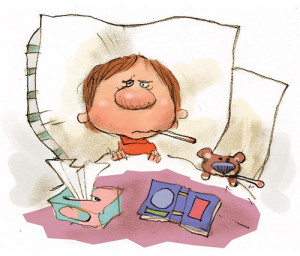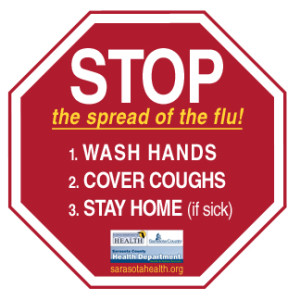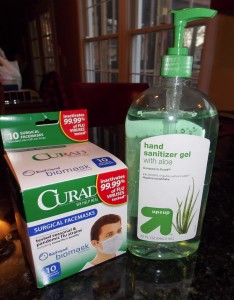My worst-case SHTF scenario: Facing a global pandemic. A pandemic that cuts all supply chains, destroys public services (electricity, water, medical, and government) and throws civilization into uncontrolled chaos.
 Unless you have had your head in the sand this past month, you are probably thinking about, and watching, this current flu epidemic. I took this as an opportunity to study up on the biggest global bout with the flu, known as the Flu of 1918 or the “Spanish Flu”. We’ve all heard how tons of people died from this flu (it killed 20 to 50 million people — 1 to 3 percent of the world’s population at that time). But there were three giant facts that surprised me:
Unless you have had your head in the sand this past month, you are probably thinking about, and watching, this current flu epidemic. I took this as an opportunity to study up on the biggest global bout with the flu, known as the Flu of 1918 or the “Spanish Flu”. We’ve all heard how tons of people died from this flu (it killed 20 to 50 million people — 1 to 3 percent of the world’s population at that time). But there were three giant facts that surprised me:
- This flu actually lasted two full years (1918-1920), and had three specific “waves” of infection at a time when the world population was not very mobile.
- It killed quickly (in some instances only one day of symptoms)
- It killed healthy people in the 20-40 age group (not the norm for flu related deaths).
We are a million times more mobile, as a population, than we were in 1918 so our transmission rates are much higher. Although we have modern medicines, we are also starting to see resistance to those medications. A pandemic is a very believable SHTF scenario.
 Our family got hit with the flu over the long holiday. Because we instituted some severe tactics, only two of us got moderately sick, one was minimally ill, and three escaped unharmed. When the first person became ill, it started quickly with chills, 102+ fevers, and a croupy, nasty cough. Initially thinking it was just a severe cold, he didn’t go to the doctor right away so he missed the two day window for Tamiflu but he did test positive for flu. The first thing we did was to isolate him to his room. When he wasn’t in his room he wore a mask, hand sanitized multiple times, did not touch any food/cupboards/fridge to serve himself, only used disposable plates and cups, and we sanitized the counter area where he ate. Medications he took, to treat the symptoms, were ibuprofen and MucinexDM (12 hour doses of guaifenesin and dextromethorphan) with moderate success (but he still felt crappy). The second person, our daughter, became ill by accidentally drinking from the first person’s cup. Like the first person, we isolated her at home and treated her with the MucinexDM. Unfortunately she got the vomit portion of the flu and she DID have to go to the emergency room for an IV to treat the dehydration migraine and vomiting. The last person to become ill only suffered from cold symptoms and chills. In all three cases, the people have suffered from a long term dry cough that has taken weeks to go completely away.
Our family got hit with the flu over the long holiday. Because we instituted some severe tactics, only two of us got moderately sick, one was minimally ill, and three escaped unharmed. When the first person became ill, it started quickly with chills, 102+ fevers, and a croupy, nasty cough. Initially thinking it was just a severe cold, he didn’t go to the doctor right away so he missed the two day window for Tamiflu but he did test positive for flu. The first thing we did was to isolate him to his room. When he wasn’t in his room he wore a mask, hand sanitized multiple times, did not touch any food/cupboards/fridge to serve himself, only used disposable plates and cups, and we sanitized the counter area where he ate. Medications he took, to treat the symptoms, were ibuprofen and MucinexDM (12 hour doses of guaifenesin and dextromethorphan) with moderate success (but he still felt crappy). The second person, our daughter, became ill by accidentally drinking from the first person’s cup. Like the first person, we isolated her at home and treated her with the MucinexDM. Unfortunately she got the vomit portion of the flu and she DID have to go to the emergency room for an IV to treat the dehydration migraine and vomiting. The last person to become ill only suffered from cold symptoms and chills. In all three cases, the people have suffered from a long term dry cough that has taken weeks to go completely away.
Isolation is the best method for treating a big flu outbreak. But in America that is something we just aren’t good at. We are very mobile and we insist on working, shopping and doing pretty much everything while we are sick (all the while spreading our germs as we go along). In Japan though, when we had a big flu outbreak, it was routine to close a public school down (or businesses or whatever) for a week and decontaminate it; while allowing the virus to, hopefully, work its way through the population AT HOME. What a great way to keep from infecting more people!
Medical masks are also key in reducing contamination rates in a mobile population but most people misunderstand how they work. When sneezing or coughing, germs can travel in the air up to six feet or so and remain active for hours. Masks are primarily used to keep an infected person from spraying their germs outward, NOT to prevent a person from breathing in germs. When you see pictures from Japan of people wearing masks, those are the sick people going about their lives while limiting their illness from transferring to others. This is a culture that is centered on being considerate and concerned with how their behavior affects others and it is considered rude to cough and hack in public and NOT wear a mask. Masks are available everywhere in Japan, including a big section at the dollar store where they come in all different sizes, colors and cartoon characters. But here in America you rarely see anyone cover their cough with a mask and most often that masked person is looked down on as being some sort of germaphobe. Our own cultural norms work against us when it comes to how we deal with illness.
 In a medical study testing the efficiency of masks at preventing an infected person from spraying their germs, it was found that N95 masks had the same effectiveness rate as a plain medical mask at suppressing the passing of germs into the air through coughing and sneezing. So the good news is that you can stock up on the plain and less expensive masks! You certainly can choose to wear a mask in an effort to prevent breathing in germs, though the masks are not air tight and germs can enter from the sides. You are also still susceptible to any surface contact with germs; they can live up to eigh hours on surfaces so it is important to wash your hands regularly, use hand sanitizer and clean any and all surfaces touched by an infected person. Similarly, most people are contagious with the flu for a day or two prior to experiencing symptoms. If you go out in public, mask or not, you are going to come in contact with the virus.
In a medical study testing the efficiency of masks at preventing an infected person from spraying their germs, it was found that N95 masks had the same effectiveness rate as a plain medical mask at suppressing the passing of germs into the air through coughing and sneezing. So the good news is that you can stock up on the plain and less expensive masks! You certainly can choose to wear a mask in an effort to prevent breathing in germs, though the masks are not air tight and germs can enter from the sides. You are also still susceptible to any surface contact with germs; they can live up to eigh hours on surfaces so it is important to wash your hands regularly, use hand sanitizer and clean any and all surfaces touched by an infected person. Similarly, most people are contagious with the flu for a day or two prior to experiencing symptoms. If you go out in public, mask or not, you are going to come in contact with the virus.
Our bout with the flu was by no means what I would term as a severe case because in both instances the fever was reduced by medications and overall the symptoms were manageable at home. My daughter suffers from recurring migraines so we do not necessarily consider her ER visit an acute occurrence of the flu. All that said, we were prepared to treat the flu here at home for an extended period of time if necessary, but how many “average citizens” have a stock pile of food, meds, masks, and sanitizer in their closet? Keep up the good preps folks, and cover that cough!





